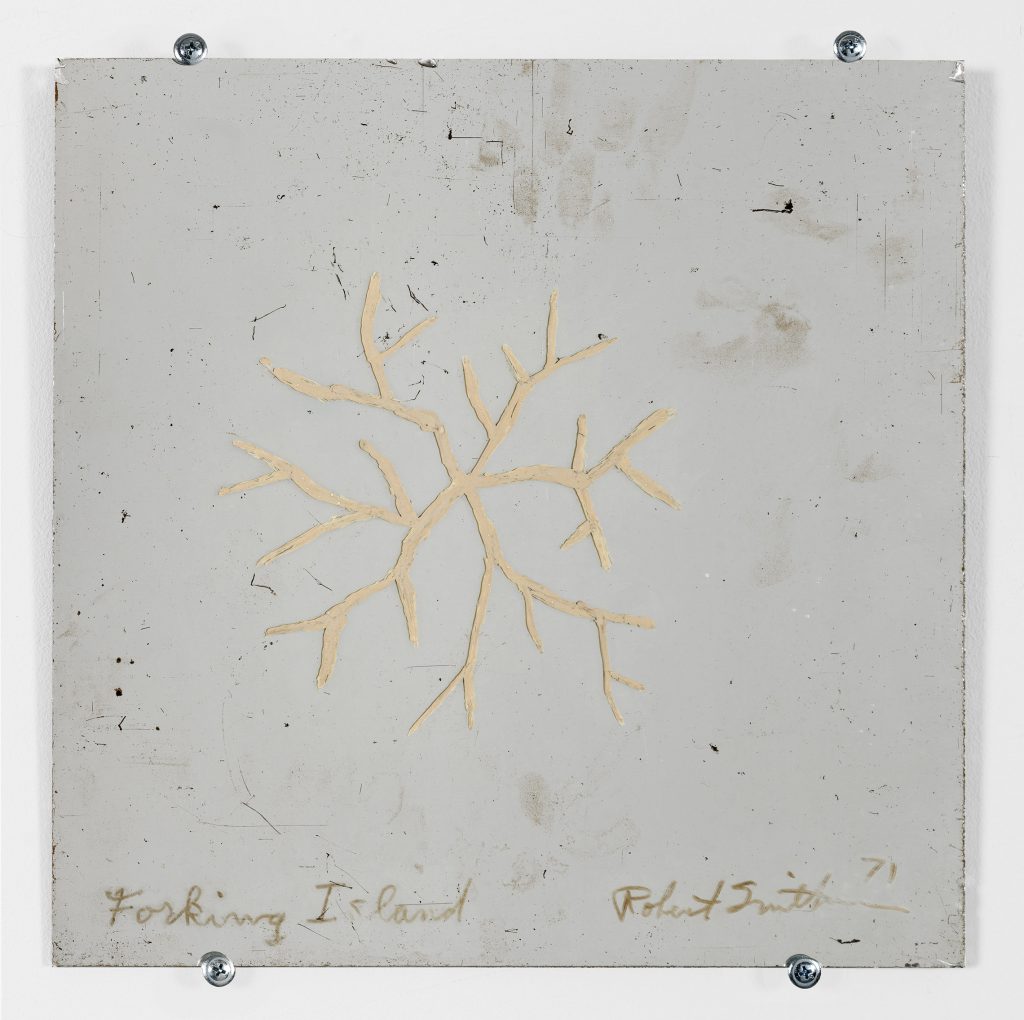
Displayed in Robert Smithson’s current exhibition at Marian Goodman Gallery is the artist’s unrealized Forking Island (1971), rendered in paint on a mirror. With its searching projections reaching outward from a central point, the island looks less like a landmass and more like a network, its form presenting a problem to the hypothetical cartographer. We are so used to thinking of landmasses as isolated, bounded entities, easily reducible to dots on a map. So what are we to make of an island that forks, an island that is a constellation of points and lines, an island that is hypothetically inhabitable on a human scale but nevertheless looks like a microscopic organism? Islands are neither distinct nor self-sufficient, even if the limits of their shores might try to tell us otherwise.
Hypothetical Islands, Smithson’s first solo exhibition in the United Kingdom, was originally scheduled to open in May 2020, but was postponed due to the pandemic. As it happens, Forking Island would have gone on view the same month that Nigel Farage, right-wing provocateur and Brexit engineer, sailed into the English Channel with the determination to keep Britain from branching. The UK was entering month two of lockdown, and still coming to terms with a strange sense of scale—one that was not new, but had rather come into sharper relief due to restrictions on movement. For many, the borders of lived experience had shrunk to the size of an apartment, turning the domestic space into an island among other islands, physically closed but mediated, connected, and sustained by global digital networks. It was at this moment that Farage left “lockdown island” (whose shores he was ambivalent toward) and cast away from Britain, a collection of islands he worked to isolate during the successful Brexit campaign. He policed the Channel, filming a boat of migrants.
At this moment, a tired metaphor snapped into focus, one that conflates people and illness under the banner of “foreignness.” The immune system is often imagined inaccurately as an army guarding against invaders, just as border patrols protect the integrity of a nation. In her book On Immunity (Graywolf Press, 2014), writer Eula Biss mines the pitfalls inherent to the conception that bodies—both personal and national—are pure, inviolable entities, somehow distinct from their surroundings. Microbes are within our bodies from birth; our adaptive immune system could have relied on virus DNA to develop its essential function. “In the garden of the body,” Biss writes, “we look inward and find not self, but other.” Indeed, as many theorists and historians writing in the midst of the global covid pandemic have observed, such insular views have proven to be untenable, and never were to begin with; it’s clear that we need a new framework for understanding the relationship between ourselves, the Earth, and our communities. Writing in the pages of Artforum the month of Farage’s excursion, the philosopher Paul B. Preciado asserted:
Contrary to what one might imagine, our health will not come from a border or separation, but only from a new understanding of community with all living creatures, a new sharing with other beings on the planet. We need a parliament not defined in terms of the politics of identity or nationality: a parliament of (vulnerable) bodies living on planet Earth.
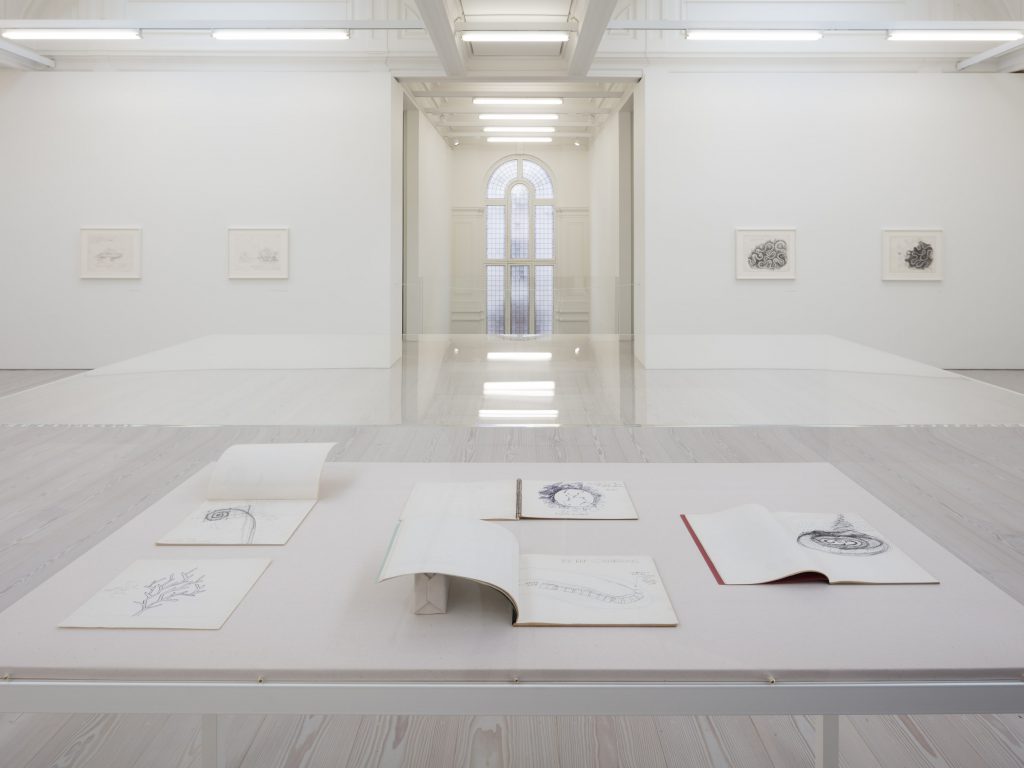
In this moment of expanding and contracting islands, of rising nationalism and climate emergency, it’s strange to think that the work of Robert Smithson, an artist who died in 1973, could say anything to address our contemporary condition. But this is what Lisa Le Feuvre told me in a recent conversation: “It feels that [Robert Smithson’s] work is more important now than it ever has been before.”
As the Executive Director of the Holt/Smithson Foundation, Le Feuvre and I were speaking in June while Hypothetical Islands was in limbo. Pushed back until November 10, the show pivoted to an online viewing room when England went into its second nation-wide lockdown earlier that month. With the lifting of restrictions on December 2, Hypothetical Islands finally opened to the public. The conspicuous absence in the UK of an artist profoundly important to curators, critics, and students of art alike, Le Feuvre suggested, might be due in part to the enduring image of Smithson as synonymous with the American landscape and his interventions within it. Referring to the artist’s most famous work, Le Feuvre reflected that “Maybe there is a myth that Smithson is [only] the Spiral Jetty guy.”
Hypothetical Islands promises to go a long way in correcting this misconception of Smithson as a distinctly American artist while underscoring his enduring relevance to contemporary issues. Bracketing for a moment the fact that Smithson produced numerous works outside of the US, it is conceptually untenable to pin an artist so invested in examining questions of time and scale to one particular location. Limits, borders, and boundaries course throughout his body of work—the very existence of these conceptual devices for sectioning space automatically assumes the presence not of one place, but two: an inside and an outside, a here and elsewhere. Smithson delighted in the muddy thinking that exists in the liminal space between categories. Speaking of his Island of Broken Glass—a never-realized project in which 100 tons of glass shards would cover a small island off the coast of Vancouver—the artist reflected: “The shore there is uncertain . . . once you start thinking about the possibility of finding that edge, you could arrive at something. What I don’t know.”
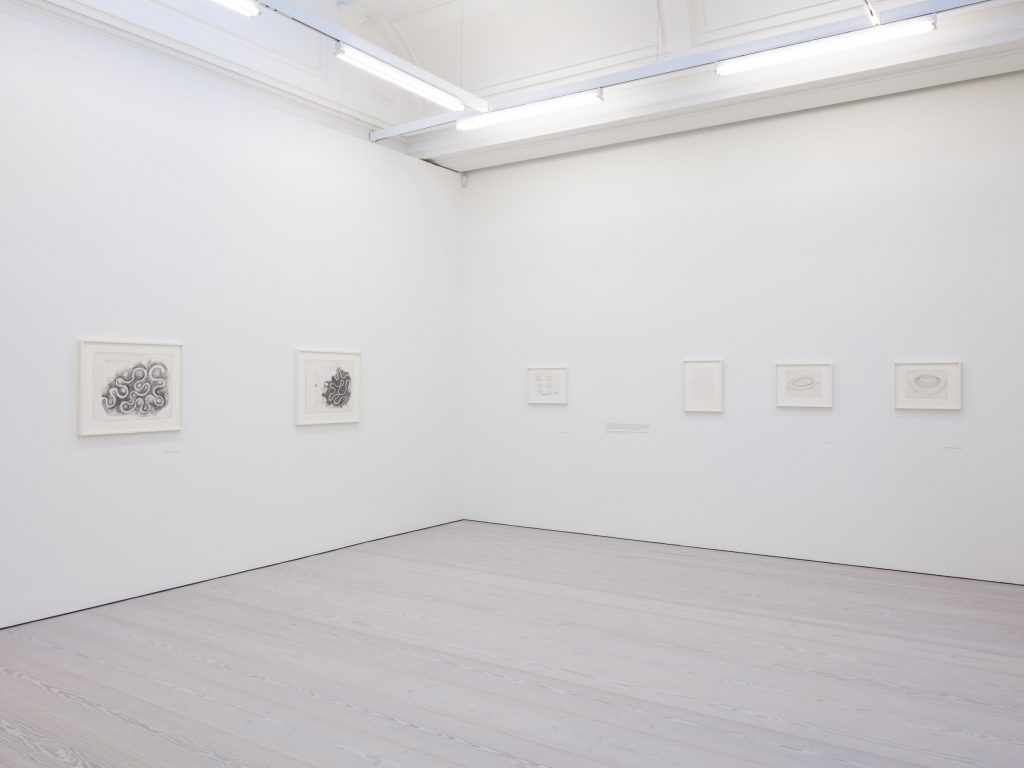
As the exhibition makes clear, Smithson’s infatuation with islands and their recurrence in his art had nothing to do with any understanding of these geological formations as distinct, physical landmasses. They were, instead, illusive entities, conceptual playgrounds where the artist was able to think through what it meant to live as part of a wider ecology, with all of the shifts in engrained perception and logic that this requires. During our conversation, Le Feuvre drew upon Édouard Glissant’s important writings on the Caribbean and his influential thesis that decentered, networked thinking can challenge dominant Euro-centric and monolithic narratives of history. “Islands are metaphorical, allegorical, hypothetical and they’re so bound up with histories of capitalism and colonialism,” Le Feuvre told me. “I think that’s something we can bring out in this exhibition.”
Hypothetical Islands is composed primarily of Smithson’s drawings of speculative islands, spanning both floors of the Goodman Gallery. While some might be called “plans” as they were evidently executed with the clear intention of realizing them physically, most appear conjectural. Many lack any proposed measurement or size for the islands themselves, indications of their constituent materials, or specific locations. Smithson’s abbreviated style often approaches deadpan humor. The pencil drawing for Island of Ashes, for example, depicts a smoldering pile of logs engulfed in flame, shorthand waves in the foreground, a shaded mountain range in the back. A note at the bottom reads that the logs are “to be burnt in order to get heaps of ash.”
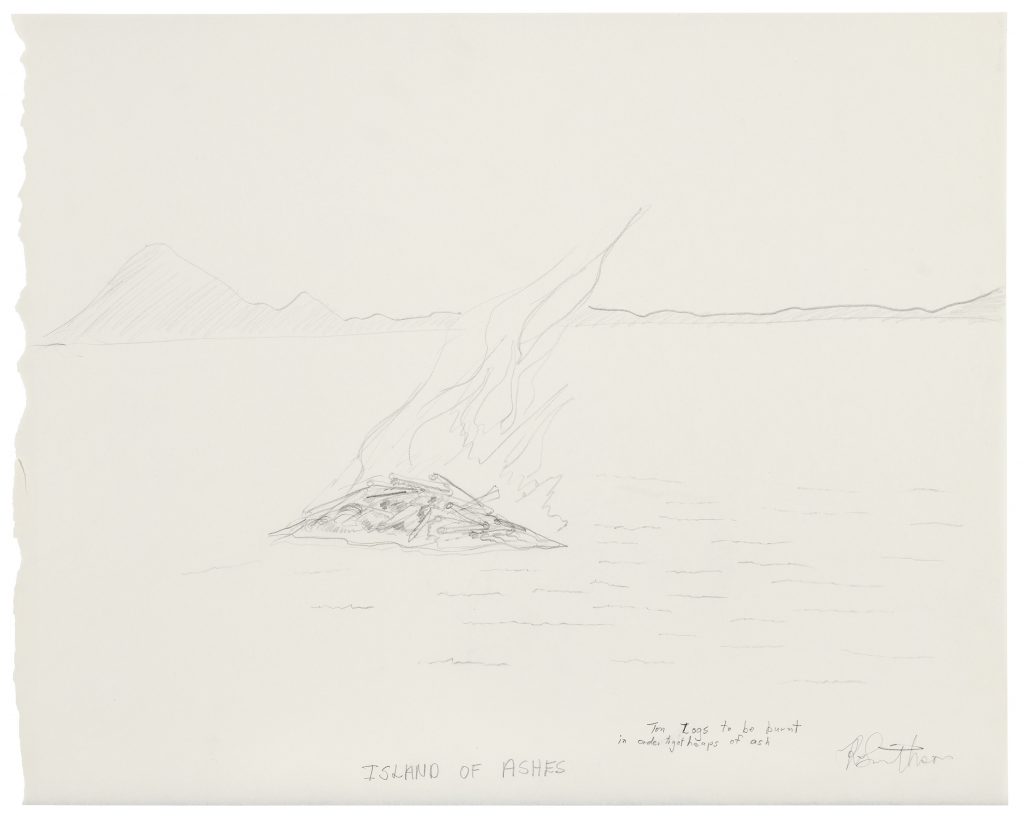
But there is a method behind Smithson’s perfunctory execution, and it resounds throughout the exhibition as a whole. Beside a 1971 drawing titled Lake of 32 Islands—composed solely of conical mounds of uncertain material, numbered 1 through 32, and nested inside a heavily sketched boundary line—a snippet of wall text gives a reason for the absence of concrete measurement. Smithson was interested in scale, not size. The former is irreducible to measurement; the latter defined by it. In his text accompanying the monumental earthwork Spiral Jetty, Smithson wrote:
Size determines an object, but scale determines art. A crack in the wall if viewed in terms of scale, not size, could be called the Grand Canyon. A room could be made to take on the immensity of the solar system. Scale depends on one’s capacity to be conscious of the actualities of perception. When one refuses to release scale from size, one is left with an object or language that appears to be certain. For me scale operates by uncertainty.

Most of the islands on view, therefore, are uncertain and ambiguous in scale. Others are designed to disorient completely. Consider one of several “island mazes” in the show. Inside an undulating contour line, a series of lashed pencil strokes whirl around an empty center. An arrow points to one of these heavily marked lines, labeled “Rocks.” Though Smithson wrote “Island Maze” on the corner of the paper, it is clearly more of an archipelago, a collection of islands. Such scalar instability is endemic to island life. Le Feuvre, who grew up on Guernsey in the English Channel, told me that “When you’re from an island, your island really is the world. And your sense of scale is particular. I remember very well as a child my father complaining to me that he had to drive me all the way to the other end of the island—fifteen minutes.” The uncertainty of islands, their ability to expand and contract, their illusive boundaries, proved to be fertile ground upon which Smithson could reflect on the nature of perception and what it meant to be human.
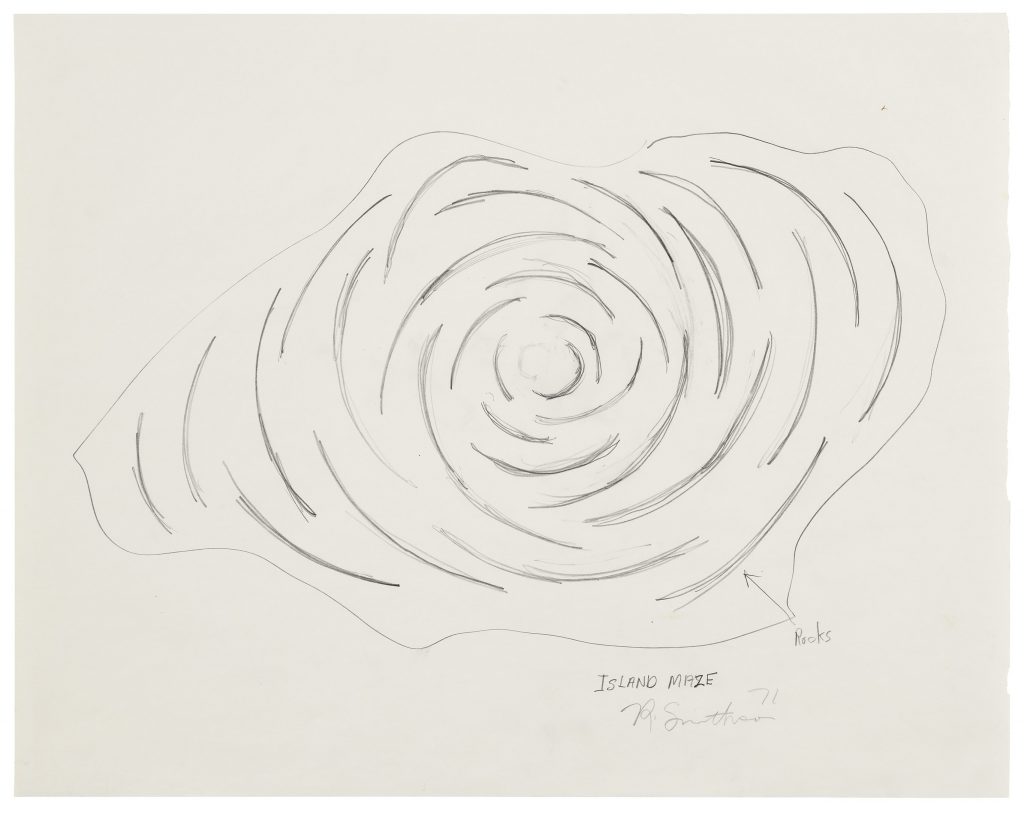
Throughout his career, Smithson challenged engrained infrastructures of thought and vision that set “humans” apart from the rest of the world, cleaving nature and culture into two remote islands. Sometimes the alternative vision he proposed was distinctly animalistic, once asserting that “If an artist could see the world through the eyes of a caterpillar he [sic.] might be able to make some interesting art.” Elsewhere, Smithson turned to blindness. On view in a darkened room in Hypothetical Islands is an exhibition copy of an early sculpture, described in the wall text as a “visual island.” The Eliminator (1964) is composed of one plane of swirling neon light, situated between two mirrors set at an acute angle. Flashing red at regular intervals, viewers suffer fits of blindness followed by green afterimages in the pitch black environment. “The Eliminator,” Smithson wrote, “overloads the eye whenever the red neon light flashes on, and in so doing diminishes the viewer’s memory dependencies or traces. . . . The Eliminator is a clock that doesn’t keep time, but loses it.” With vision now stripped to its core, and the certainty of our position in time and space exploded, maybe we can begin the process of rethinking our place within the world.

It’s here where Le Feuvre notes that Smithson anticipates contemporary posthumanist writers like Rosi Braidotti, who has replaced the idea of a nature-culture divide with that of a continuum. “Smithson was proposing that what we need to do is collaborate with nature,” Le Feuvre said. “We need to think about a non-anthropocentric way of understanding the earth. We need to collaborate with other species to realize that we are in an ecology.” In Island Project (1970), one of the most detailed drawings in the exhibition, Smithson has rendered a nightmarish island of construction projects, either half-finished or decaying—tunnels bore through the land, a spiraling tower halts its ascent, pipes perch above the water at-the-ready to expel waste, a fire launches plumes of smoke. It looks like a dystopian Piranesi. But for Smithson, this was a fact. Humans, in his understanding, intervene into landscapes much as geological process do, once stating that “As an artist it is sort of interesting to take on the persona of a geological agent where man actually becomes part of that process rather than overcoming it.” It is also for this reason, a wall text reminds viewers, that Smithson abandoned his plans for a “Meandering Island” in Maine. The site was, in his estimation, too picturesque. That is to say it looked too much like our Romantic ideal of nature as an untouched Eden, one in which we are not present.
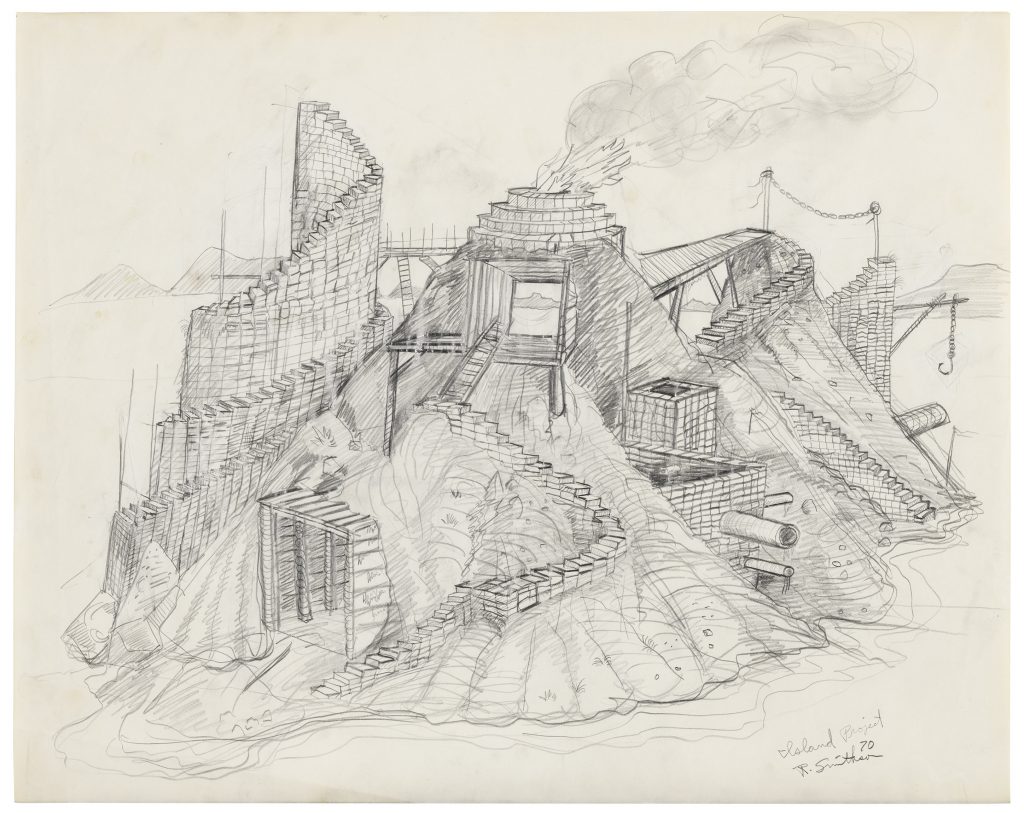
Walking through the exhibition, you can hear within the drawings the scraping of earth, machines digging their trenches, matter being dumped and bulldozed to form these hypothetical islands. But you can see it as well. Hypothetical Islands features five films, two of which document the construction of Smithson’s earthworks—the famous Spiral Jetty and the posthumously created Amarillo Ramp. During the surveying stage of the latter project, Smithson died in a helicopter crash alongside the photographer, Robert E. Curtin, and pilot, Gale Ray Rogers. The earthwork was later carried to completion by Richard Serra, Tony Shafrazi, and Nancy Holt, Robert Smithson’s wife, fellow artist, and frequent collaborator. In the film, viewers see the group dig a trench to drain the land, water releasing into a nearby field. Trucks dump and bulldozers smooth down piles of red slate to create the form of the ramp, which ascends upward in a sweeping curve.
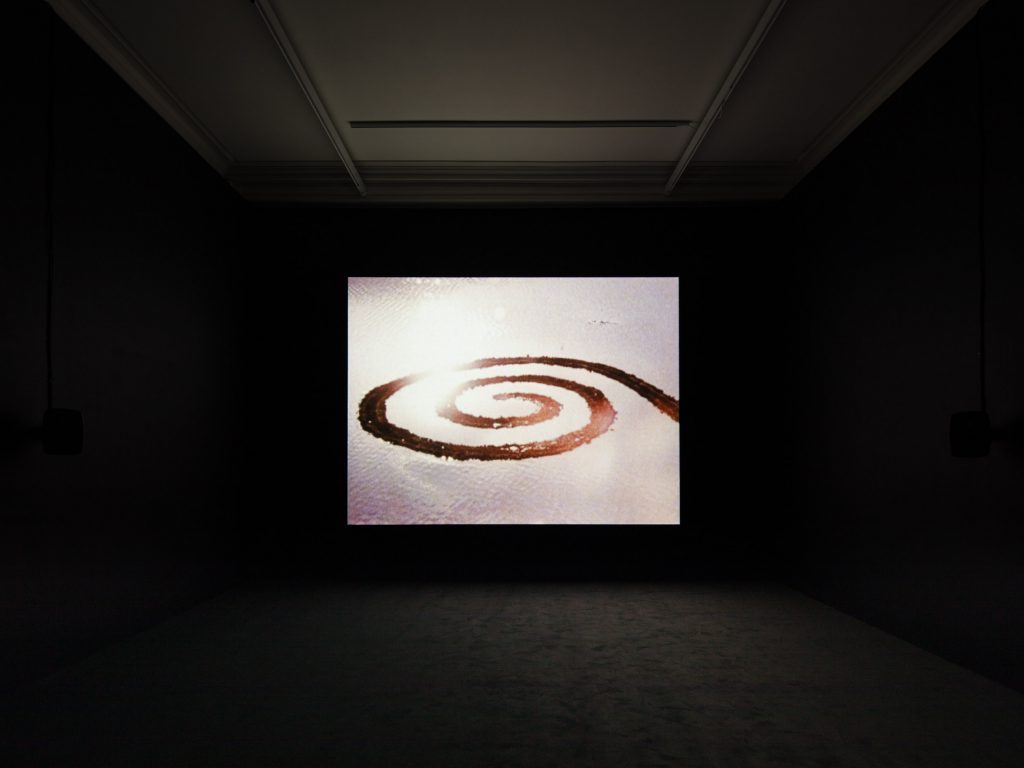
But it is in the Spiral Jetty film where such earth-moving is viscerally felt. The Jetty’s construction process is documented in close-ups of black basalt rock cascading downward from the jaws of bulldozers, motors blaring, gears churning, raw matter smashing and splashing into the shallow water of the Great Salt Lake. On the big screen, it looks like we are witnessing a seismic geological event. But lest we think that this film and earthwork is a testimony to humanity’s ability to heroically conquer and assert its will upon nature, Smithson once again basks in scalar slippage that careens viewers into sublime disorientation. In breathtaking shots of the Jetty, captured via swooping and gliding helicopter, our vision becomes unmoored. In one of the film’s many striking sequences, the camera peers downward on the Jetty, the sun blazing in water tinted red with algae. A glowing orb appears, hovering on the cusp of visibility as Smithson intones: “Gazing intently at the gigantic sun we at last deciphered the riddle of its unfamiliar aspect. It was not a single flaming star but millions upon millions of them, all clustering thickly together like bees in a swarm. Their packed density made up the deceptive appearance of solid, impenetrable flame. It was in fact a vast spiral nebula of innumerable suns.” Just as the appearance of a solid sun shatters, so too does the Jetty, its spiraling shape refracting in the myriad salt crystals that grow on the rocks in their own spiral formation. After visiting the earthwork some time after its completion, Smithson remarked on its appearance, “a kind of archipelago of white islands because of heavy salt concentrations.”
Hypothetical Islands, with its framing of humanity within the large expanse of geological time, its cultivation of an ecological perspective, could not be more timely. Speaking with Le Feuvre over the summer, I was reminded that Britain was in the process of re-negotiating its borders. Its shorelines, once coterminous with Europe, will magically shrink to the size of the isles as Brexit rings in 2021. “The island nature of Britain is something incredibly pertinent now,” she told me. “It’s going to be a rather disconnected and non-European island.” But it is also an island of uncertain scale. We can see Britain as geographically small and distinct, or historically very large, depending on how, to quote Smithson “your consciousness focuses.” Centuries earlier, the sun never set on British shores, the empire branching across the world while spreading the idea of what it meant to be human, and propelling a history that we must continue to reckon with.
The work on view Hypothetical Islands requires patience from viewers. The films can plod along, and Smithson won’t be receiving many plaudits for his draftsmanship. But the exhibition isn’t staking any claims on the elegance of his hand or fluency of his drawings. Rather, Hypothetical Islands foregrounds the conceptual framework of an artist whose own eclectic cosmology can at times appear to be both intimidating and impenetrable. For an artist’s first solo show in a new country, one might expect to see the heavy-hitters—in Smithson’s case, emphasis on the Spiral Jetty and his site-nonsite projects. But in focusing on his islands, the exhibition illuminates Smithson’s profound importance for today, and features glimpses into the ecological vision that forms the foundation for his most famous works. In doing so, Hypothetical Islands offers Smithson a possible escape from “Land Art Island” where he has been marooned for so long.
Hypothetical Islands is on view at Marian Goodman Gallery, London, through January 9, 2021. A second exhibition of Smithson’s work, Primordial Beginnings, is running concurrently at the gallery’s Paris location.
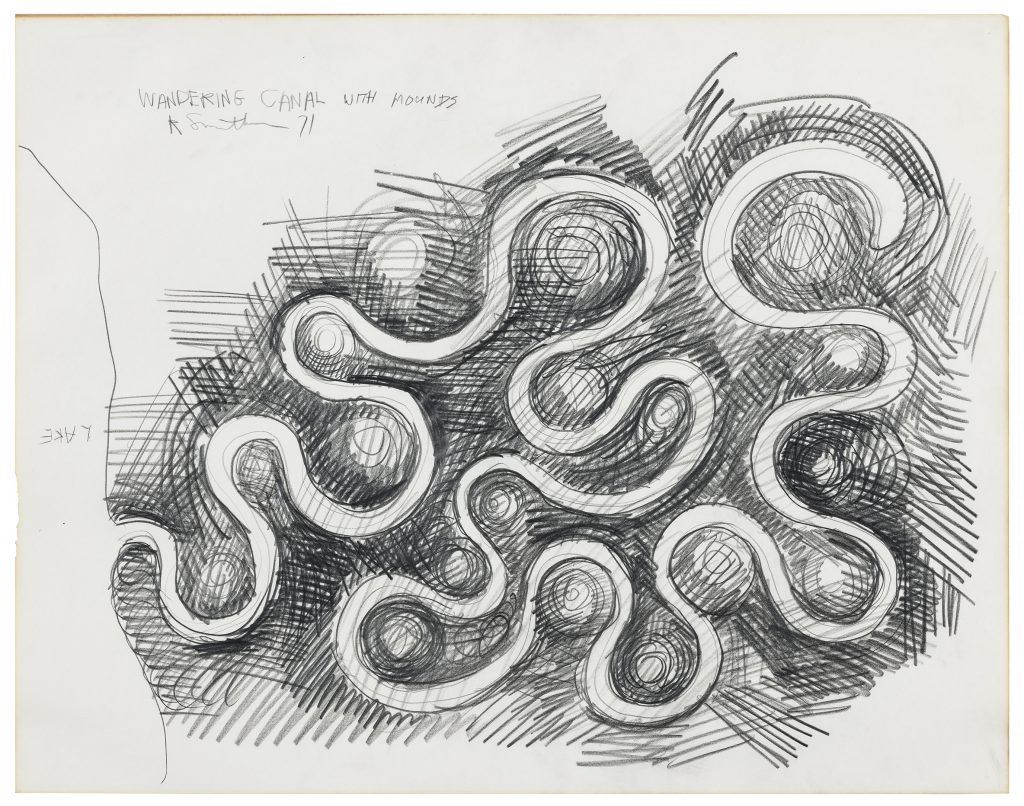
Text © Nathan Jones 2020
What an explanatory text it looks simple but it’s not i like this kind of thing i liked.
Your website is amazing congratulations, visit mine too:
https://strelato.com
.
thanks for info
Hey there, I appreciate you posting great content covering that topic with full attention to details and providing updated data. I believe it is my turn to give back, check out my website YH6 for additional resources about Airport Transfer.